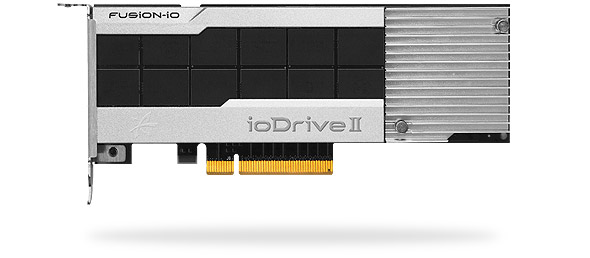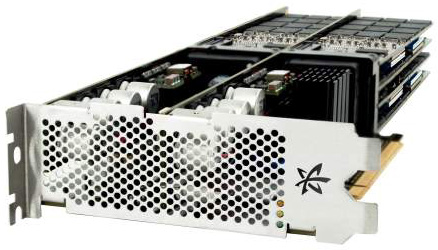The Impact of Disruptive Technologies on the Professional Storage Market
by Johan De Gelas on August 5, 2013 9:00 AM EST- Posted in
- IT Computing
- SSDs
- Enterprise
- Enterprise SSDs
Fusion-IO: the Pioneer
Fusion-IO is telling everyone that wants to listen that it is much more than the vendor of extremely fast PCIe flash cards. Despite the fact that it sells quite a few cards to the storage giants like NetApp, Fusion-IO wants nothing less than to completely change and conquer the storage market.
Fusion-IO's first succesful move was to sell extremely fast ioDrives to the people who live from scale-out applications like Facebook and Apple. These companies ditched their traditional SAN environments very quickly as replacing centralized shared storage by a model where hundreds of servers have a local PCIe flash storage system gave them up to ten times more storage performance at a fraction of the cost of a high-end SAN system.
Ditching your centralized storage is not for everyone of course: your application has to handle replication and thus be able to survive the loss of many server nodes. But as we all know, that is exactly what Google, Facebook, and other scale-out companies did: build applications that replicate data between nodes so that nobody has to worry about a few failing nodes.

The Iodrive: up to 3TB, hundreds of thousands of IOPS
Although scale-out customers were extremely important to Fusion-IO, the company also went also after the virtualization market where centralized storage is king. The ioTurbine is a Hypervisor plug-in that enables server side caching on a virtualized host with a Fusion-IO flash card. The beauty is that ioTurbine does not disable the typical goodies that centralized storage offers in a virtualized environment such as vMotion and High Availability. ioTurbine works with ESXi, Windows 2012/2008 and RHEL.
Fusion-IO ION Data Accelerator is the next generation SAN: PCIe Flash cards inside any decent x86 server, like the Supermicro 6037 or the HP DL380p. ION is typically used for high-end database clusters. Fusion-IO promises that this shared storage can deliver no less than 1 million IOPs.
With the acquisition of NexGen Storage, Fusion-IO is also targeting the midrange market by offering a “flashpool” kind of product. The key difference is that NexGen Storage can use write-back caching, while most vendors do no or limited writing on the flash disks. The Fusion-IO software is also able to provision a certain amount of IOPs for each LUN.
.jpg)
But more than anything else, the Fusion-IO products are offering extreme speeds. Even a one array NexGen N5 series targeted at SMBs promise 100K-300K IOPs, more than any of the much more expensive midrange SANs can offer right now.

The fastest product, the 10TB ioDrive octal, costs around $100k and delivers 1 million IOPs. Even if those numbers are inflated, it is roughly an order of magnitude faster and cheaper (per GB) than the NetApp “Flash Cache”.










60 Comments
View All Comments
jhh - Wednesday, August 7, 2013 - link
And Advanced/SDDC/Chipkill ECC, not the old-fashioned single-bit correct/multiple bit detect. The RAM on the disk controller might be small enough for this not to matter, but not on the system RAM.tuxRoller - Monday, August 5, 2013 - link
Amplidata's dss seems like a better, more forward looking alternative.Sertis - Monday, August 5, 2013 - link
The Amplistore design seems a bit better than ZFS. ZFS has a hash to detect bit rot within the blocks, while this stores FEC coding that can potentially recover the data within that block without calculating it based on parity from the other drives on the stripe and the I/O that involves. It also seems to be a bit smarter on how it distributes data by allowing you to cross between storage devices to provide recovery at the node level while ZFS is really just limited to the current pool. It has various out of band data rebalancing which isn't really present in ZFS. For example, add a second vdev to a zpool when it's 90% full and there really isn't a process to automatically rebalance the data across the two pools as you add more data. The original data stays on that first vdev, and new data basically sits in the second vdev. It seems very interesting, but I certainly can't afford it, I'll stick with raidz2 for my puny little server until something open source comes out with a similar feature set.Seemone - Tuesday, August 6, 2013 - link
Are you aware that with ZFS you can specify the number of replicas each data block should have on a per-filesystem basis? ZFS is indeed not very flexible on pool layout and does not rebalance things (as of now), but there's nothing in the on-disk data structure that prevent this. This means it can be implemented and would be applicable on old pools in a non disruptive way. ZFS, also, is open source, its license is simply not compatible with GPLv2, hence ZFS-On-Linux separate distribution.Brutalizer - Tuesday, August 6, 2013 - link
If you want to rebalance ZFS, you just copy the data back and forth and rebalancing is done. Assume you have data on some ZFS disks in a ZFS raid, and then you add new empty discs, so all data will sit on the old disks. To spread the data evenly to all disks, you need to rebalance the data. Two ways:1) Move all data to another server. And then move back the data to your ZFS raid. Now all data are rebalanced. This requires another server, which is a pain. Instead, do like this:
2) Create a new ZFS filesystem on your raid. This filesystem is spread out on all disks. Move the data to the new ZFS filesystem. Done.
Sertis - Thursday, August 8, 2013 - link
I'm definitely looking forward to these improvements, if they eventually arrive. I'm aware of the multiple copy solution, but if you read the Intel and Amplistore whitepapers, you will see they have very good arguments that their model works better than creating additional copies by spreading out FEC blocks across nodes. I have used ZFS for years, and while you can work around the issues, it's very clear that it's no longer evolving at the same rate since Oracle took over Sun. Products like this keep things interesting.Brutalizer - Tuesday, August 6, 2013 - link
Theory is one thing, real life another. There are many bold claims and wonderful theoretical constructs from companies, but do they hold up to scrutiny? Researchers injected artificially constructed errors in different filesystems (NTFS, Ext3, etc), and only ZFS detected all errors. Researchers have verified that ZFS seems to combat data corruption. Are there any research on Amplistore's ability to combat datacorruption? Or do they only have bold claims? Until I see research from a third part, independent part, I will continue with the free open source ZFS. CERN is now switching to ZFS for tier-1 and tier-2 long time term storage, because vast amounts of data _will_ have data corruption, CERN says. Here are research papers on data corruption on NTFS, hardware raid, ZFS, NetApp, CERN, etc:http://en.wikipedia.org/wiki/ZFS#Data_integrity
For instance, Tegile, Coraid, GreenByte, etc - are all storage vendors that offers PetaByte Enterprise servers using ZFS.
JohanAnandtech - Tuesday, August 6, 2013 - link
Thanks, very helpful feedback. I will check the paper outmikato - Thursday, August 8, 2013 - link
And Isilon OneFS? Care to review one? :)bitpushr - Friday, August 9, 2013 - link
That's because ZFS has had a minimal impact on the professional storage market.